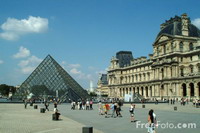Login form
France
 France attracts more tourists than any other country in the world. Tourists come to see France’s splendid scenery. But mostly they come to see Paris, the capital of France. Paris is considered one of the most beautiful cities in the world.
France attracts more tourists than any other country in the world. Tourists come to see France’s splendid scenery. But mostly they come to see Paris, the capital of France. Paris is considered one of the most beautiful cities in the world.
For centuries, France has been the center of art and culture in Europe. Some of the world’s greatest artists and writers have worked here. French fashions and cooking are widely admired and copied.
|
Facts About France |
|
|
|
|
|
Official name |
French Republic |
|
Capital |
Paris |
|
Official language |
French |
|
Population |
60,400,000 people |
|
Rank among countries in population |
20th |
|
Major cities |
Paris, Marseille, Lyon, Toulouse |
|
Area |
210,000 square miles |
|
Rank among countries in area |
47th |
|
Highest point |
Mont Blanc |
|
Currency |
Euro |
VARIED LANDSCAPES
France is the biggest country in western Europe. Most of the land in the north is flat and close to sea level. Hills cover central and southern France, and huge mountains rise along the country’s borders. The Pyrenees divide France from Spain, its neighbor to the southwest. The Alps mark its border with Italy and Switzerland to the east.
Most of France has mild weather. However, the French Alps get plenty of snow. Some of the world’s finest ski resorts are found here. In the southeast, France borders the Mediterranean Sea. The coast along the Mediterranean is called the Riviera. Warm, dry weather and beautiful scenery make the Riviera a famous winter resort. It’s long been associated with wealth and glamour.
THE FRENCH COUNTRYSIDE
The French countryside is divided into tidy farms and dotted with pretty towns. Here and there, old castles loom on hills. The castles were built hundreds of years ago, when nobles ruled France.
Big rivers, like the Loire and the Seine, provide water for French farms. Canals connect the major rivers in France. People can travel on this network of waterways. The canals are like an extra set of highways.
WINE AND CHEESE
Vineyards and dairy farms in the countryside produce products for which France is best known. Vineyards grow grapes that are made into wine. Cheese comes from the dairy farms.
France produces more wine than any other country in the world. Bordeaux, Burgundy, and Champagne are important grape-growing regions in France. All three have given their names to kinds of wine.
France also is known for producing some of the best cheeses in the world. They include Camembert, chèvre (made from goat’s milk), and Roquefort.
THE CAPITAL OF FUN
Three-fourths of the people of France live in cities and towns. France has ports, such as Marseille, and factory towns, such as Lyon. Paris, however, is by far the most important French city. About 10 million people live in and around this lively and lovely city.
Artists have long been drawn to Paris. A famous art movement called impressionism was born here. The best-known museum in France—the Louvre—is in Paris. The Louvre contains one of the world’s most famous paintings, the Mona Lisa by Leonardo da Vinci.
Tourists also love Paris for its nightlife, restaurants, and sidewalk cafés. They flock to see beautiful buildings such as Notre Dame, a huge church that is more than 700 years old. They visit the Eiffel Tower, a Paris landmark that’s nearly 1,000 feet (300 meters) high.
THE BIRTH OF FRANCE
Paris was founded more than 2,000 years ago. It was just a small town until the ad 800s. At that time, France was the western part of a big empire built by a tribe called the Franks. The greatest king of the Franks was Charlemagne. He ruled from 768 to 814. After his death, his three grandsons divided his empire. The western part eventually became France.
For about four centuries, the kings of France had little power. During a conflict with England, the French came to think of themselves as a nation. The conflict, known as the Hundred Years’ War, lasted from 1337 to 1453. After the war, the power of the French king began to grow.
The king’s power peaked with Louis XIV, who ruled from 1643 to 1715. He was known as the Sun King because he took the Sun—the brightest star in our sky—as his symbol. Louis XIV built the world’s grandest palace at Versailles, just outside Paris. All over Europe, people came to think of Paris as a center for art, culture, and fun.
THE FRENCH REVOLUTION
The fun didn’t last. The king and the members of his court lived splendidly, but the French people were dreadfully poor. In 1789, the poor rebelled. They overthrew the king and the nobles. They demanded liberty and equality for all. These events began the French Revolution, which lasted until 1799.
After the revolution, a military leader named Napoleon seized power in France. He led French armies as they conquered much of Europe. Britain and Russia joined forces to defeat him.
TODAY’S FRANCE
France remains a powerful and lively country. It is one of the most important countries in the United Nations. It is also a leading power in the European Union, an organization of European countries. Tourists never tire of Paris and other places in France. More people visit France each year than live there!
Source: Microsoft ® Encarta

